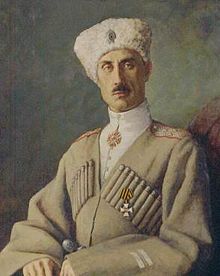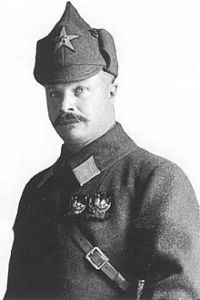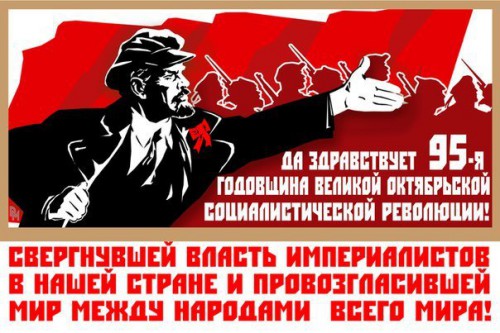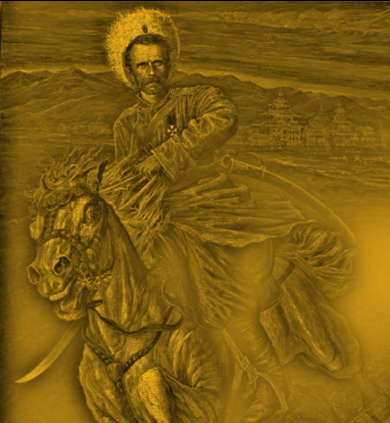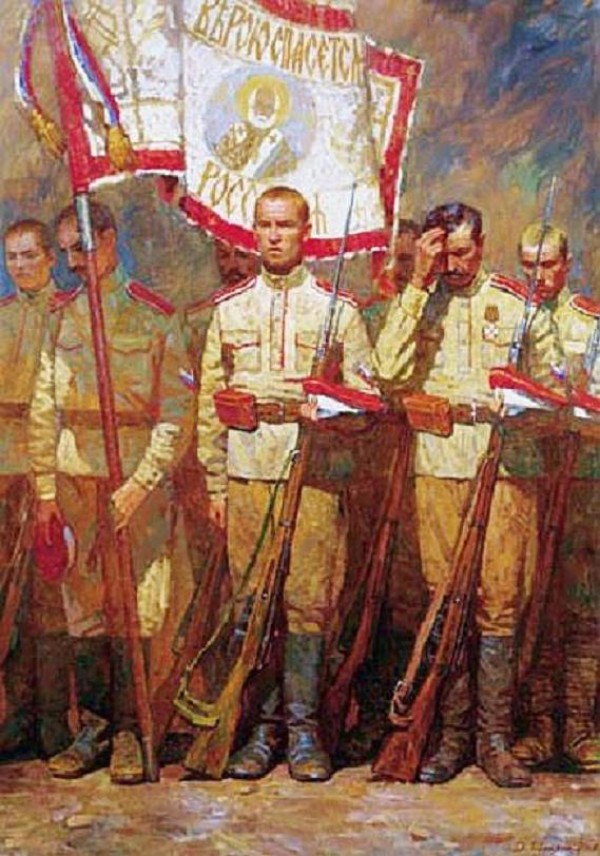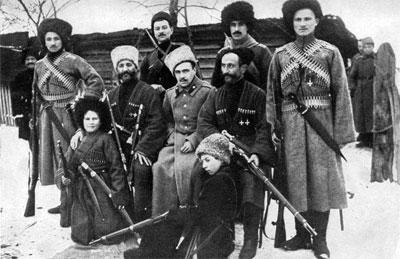Ex: http://legio-victrix.blogspot.com/
Uma das peculiaridades da contrarrevolução Branca na Rússia foi o fato de que ela emergiu e se desenvolveu quando a Guerra Mundial ainda não havia terminado. Como a Alemanha era inimiga do Império Russo durante a Guerra Mundial, foi o Alto Comando Alemão que planejou enviar Lênin e seus associados a São Petersburgo em um trem fechado. Intencionava-se que eles se tornassem um fator de desestabilização; sua única tarefa era remover a Rússia do teatro de operações bélicas europeu do lado Aliado.
Tendo estabelecido sua própria ditadura dentro do Congresso de Sovietes Lênin convocou os trabalhadores e camponeses para um levante revolucionário. Em uma fria noite de 25 de outubro de 1917 após a tomada do Zimny Dvoretz (o Palácio de Inverno - a residência do Czar em São Petersburgo) ter sido realizada, Lênin declarou a asserção oficial do poder soviético (ou seja, do poder dos Sovietes).
"Terra para os camponeses", "Fábricas para os trabalhadores", "Paz sem anexações e sem tributo", "Convocação de uma Assembléia Constituinte" - esses foram os slogans oficiais declarados. Mas nenhum deles foi realmente cumprido. Em verdade foi o sangrento regime do "comunismo de guerra", chefiado predominantemente por judeus e não-russos, que foi estabelecido.
1. Guerra e Revolução
Durante a segunda fase da Guerra Mundial - após a investida do General Alexei Brusilov na Romênia em 1916, em um momento em que os quartéis-generais do exército eram liderados pelo talentoso general Mikhail Alexeyev - toda a situação na frente ocidental se tornou favorável à Rússia.
Mas o exército era bastante solapado pela atividade de provocadores revolucionários que encorajavam soldados e oficiais a desertarem. Posteriormente, as primeiras unidades da RKKA (Exército Vermelho de Operários e Camponeses) foi formada a partir desses desertores.
Um judeu ucraniano, Lev "Trotsky" Bronstein (1879-1940) ocupou a posição de Narkom (Comissário Popular) para Assuntos Militares e Defesa no recém-nascido governo soviético. Foi graças a sua iniciativa pessoal que o vergonhoso Tratado de Brest-Litovsk foi assinado em 3 de março de 1918. Após esse Tratado, os territórios ocidentais do Império, os mais desenvolvidos em termos econômicos (aproximadamente 1/3 da população e metade da indústria) foram arrancados. Tirando vantagem das fraquezas russas temporárias, os alemães conseguiram ocupar os estados bálticos, uma parte da Bielorrússia e o Cáucaso. Ademais, eles tecnicamente reinavam na Ucrânia, onde o hetman Skoropadsky se tornou seu protegido. Os resultados de três anos de batalhas intensas pelo povo russo em sua frente ocidental foram anulados.
Um "Comitê Revolucionário Militar" foi estabelecido no lugar dos antigos corpos estatais e do Governo Provisório Kerensky. Inúmeros comitês bolcheviques menores, bem como agências punitivas de terror, como a Cheka, posteriormente GPU e NKVD, também foram formadas.
Contando com a crença do povo comum no "Estado de Justiça Social", os comissários vermelhas chamaram o povo para realizar uma Revolução Global e estabelecer a "Ditadura Global do Proletariado". Em nome da "luta de classes" grandes propriedades, fábricas e casas foram expropriadas pelos bolcheviques por todo o país. Simultaneamente, representantes da aristocracia, do clero, do alto domando do exército e das classes superiores foram virtualmente exterminados. A economia começou a tropeçar graças a distúrbios e devastações.
A maior parte da população, que inicialmente acreditava que o poder dos bolcheviques seria temporário, se importava mais em salvar suas vidas e propriedade. Mas políticas e líderes experientes gradualmente começaram a guiar a nação no entendimento de que era necessário resistir à revolução e seu caos. A contrarrevolução começou; a cor branca foi escolhida como sua, já que ela tradicionalmente simbolizava a monarquia e a glória do estandarte russo.
2. Primeiras tentativas de resistência armada
Centros de resistência armada apareceram por todos os territórios do antigo império - do noroeste ao extremo oriente. Mas eles eram diferentes em termos de escala, duração das ações armadas, e de seus resultados. Levantes espontâneos ocorreram entre camponeses com bastante frequência, mas eles foram severamente suprimidos pelo exército vermelho. Os restos das forças militares organizadas, fiéis ao antigo Czar e à Pátria, tentaram se unir em um fronte sólido. Juntos eles formaram o Movimento Branco com centros ativos e quartéis militares por toda a Rússia.
As primeiras tentativas de resistência armada contra as forças revolucionárias foram realizadas durante o mando do Governo Provisório burguês-democrata, chefiado por Alexander Kerensky, em março de 1917, muito antes dos bolcheviques realizarem seu Golpe de Estado. A rebelião do Beneral Lavr Kornilov que ocorreu em setembro de 1917 mostrou que a própria idéia da "democracia parlamentar" era inaceitável nos círculos militares e patrióticos.
General Kornilov (1870-1918) foi um cossaco hereditário e um excelente líder militar. Tendo se graduado na escola de artilharia e posteriormente na Academia do Estado Maior (com uma medalha de ouro por feitos notáveis), ele serviu como adido militar na embaixada russa na China. Ele começou sua carreira militar como oficial durante a Guerra Russo-Japonesa (de 1904-1905), e foi promovido ao posto de Comandante-em-Chefe do Exército Imperial Russo durante a Primeira Guerra Mundial. Ele era um comandante experiente, foi decorado com a Cruz de São Jorge e desfrutou de um grande prestígio entre os soldados comuns do exército. Ele foi o primeiro a erguer o estandarte da Causa Branca e muitos esperavam que ele se tornaria um ditador, capaz de esmagar a revolução comunista vindoura.
Em 27 de agosto de 1917 o General Kornilov abordou o povo russo com um telegrama no qual ele acusava os bolcheviques de cederem aos alemães e convocava seus compatriotas a se unirem a suas fileiras para a salvação da Pátria. ele jurou "liderar o povo à Assembléia Constituinte, através da qual eles poderiam tomar seu destino em suas próprias mãos, para escolher a forma do novo Estado". Mas Kornilov não desfrutava de muito apoio nessa fase de sua luta e teve que baixar as armas.
A revolução comunista então eclodiu. O famoso batalhão da morte feminino, liderado pela comandante Maria Bochkareva demonstrou o verdadeiro exemplo de heroísmo e devoção à Pátria. Junto com várias centenas de cadetes militares elas defenderam o Palácio de Inverno contra os bolcheviques. Essa unidade feminina única foi criada no meio da Primeira Guerra Mundial para manter elevado a moral dos soldados, que estavam perdendo fé na vitória. O batalhão tinha por volta de 3.000 dessas amazonas russas e tinha seu próprio estandarte; ele foi solenemente santificado na Praça Vermelha. Mas as mulheres armadas não foram capazes de resistir aos revolucionários bolcheviques e seus aliados.
Submergindo nas profundezas do caos revolucionário, a Rússia teve que descontinuar suas operações militares nos frontes da Guerra Mundial. Graças ao golpe bolchevique, o país se tornou presa fácil para seus antigos aliados bem como para seus inimigos. Nessa situação apenas um exército contrarrevolucionário regular, liderado por profissionais das escolas militares czaristas, seria capaz de resistir ao perigoso inimigo que havia tomado os postos centrais do Estado. Havia necessidade de líderes Brancos de vontade férrea para unir a nação.
A contrarrevolução logo começou a assumir a forma de uma resistência armada organizada. A primeira tentativa de liberar São Petersburgo dos bolcheviques ocorreu nas Colinas de Pulkovo em 12 de novembro de 197. Ela foi realizada por um esforço conjunto de Alexander Kerensky (que havia conseguido fugir da capital) e do General Peter Krasnov (1869-1947). Esse foi efetivamente o início da luta armada Branca. Mas um regimento de 700 cossacos não foi o bastante para realizar essa difícil missão. Os tumultos e levantes de trabalhadores por toda a capital apenas aceleraram a situação. Sob essas circunstâncias, em 15 de novembro o General Alexeyev e todo seu séquito tomaram a decisão de formar o Exército Voluntário.
3. O Exército Voluntário e a "Marcha de Gelo" de 1918
O General Mikhail Alexeyev (1857-1918) foi um brilhante líder militar, um verdadeiro cientista da guerra e um homem culto. Ele nasceu na família de um oficial militar e seguiu o caminho de seu pai. Alexeyev concluiu a Escola de Infantaria Militar de Moscou, e a Guerra Russo-Turca de 1877 foi seu "batismo de fogo". Após isso, ele foi indicado professor, Alexeyev obteve uma cadeira em História Militar na Academia do Estado Maior. Lá seus talentos notáveis se tornaram evidentes.
Alexeyev não se ocupou apenas com serviço burocrático - durante a Guerra com o Japão ele foi indicado para o campo de batalha após ter pedido. Pouco antes da Primeira Guerra Mundial Alexeyev foi apontado chefe do Comando de Kiev por suas impressionantes realizações militares. Durante a guerra ele estava encarregado do fronte sudestino e foi graças a seu talento como seu comandante que a situação crítica no fronte alemão melhorou.
O Czar Nicolau II tendo abdicado, o Governo Provisório indicou Alexeyev Supremo Comandante-em-Chefe. Mas pouco depois o general foi dispensado graças a sua atitude crítica frente a política do governo burguês. Depois que o poder foi tomado pelos bolcheviques, Alexeyev e seus camaradas de armas tiveram que recuar para o sul para dar início a uma nova fase da guerra.
No vale do Rio Don viviam cossacos livres que haviam provado sua fidelidade à Pátira por meio do serviço militar por séculos. Foi lá que a formação dos primeiros Guardas Brancos teve início. O núcleo do exército estava agrupado ao redor da "Cruz Branca", uma sociedade secreta formada por oficiais militares. Logo, generais Kornilov e Denikin bem como os atamans (comandantes cossacos) Kaledin (1861-1918) e Dutov (1879-1921) se uniram à sede do Exército Voluntário. Os cossacos do Don, de Orenburg e Baikal, furiosos com a ditadura judaico-comunista e com o terror revolucionário ergueram-se para se unir aos voluntários. "Lá ergueram-se em sua nobre ira cristãos verdadeiros, filhos do Don, e ouviram o chamado da liberdade!" - assim seguiam as linhas de uma velha canção cossaca.
A chamada "Marcha de Gelo" do Exército Voluntário liderado por Kornilov se tornou o primeiro evento notável da primeira fase da guerra. Ela começou em fins de fevereiro de 1918 e prossegiu sob severas condições invernais, quatro mil voluntários com alta moral preparados para romper pelas linhas vermelhas após cruzarem o Don. Foi o "batismo de fogo" para o Exército Branco e Alexeyev chamou isso de "uma vela de fé e esperança nas trevas que estavam devorando a Rússia". Mas a campanha falou; os voluntários Brancos eram superados numericamente pelos Vermelhos e tiveram que recuar. O General Kornilov caiu como um verdadeiro guerreiro na Batalha de Ekatrinodar.
4. Ditadura Bolchevique e o Terror Vermelho
Os líderes militares acreditavam que uma força armada organizada era necessária para a recuperação da paz e da ordem civil, enquanto os cidadãos pacíficos, confusos pela propaganda constante, jamais abandonaram a esperança de restaurar a paz por meios democráticos legais.
Em 18 de janeiro de 1918, a Assembléia Constituinte de Todos as Rússias, apoiada por ativistas proletário, começou a funcionar em São Petersburgo. Mas apesar de ser pacífica, a Assembléia foi imediatamente atacada por bolcheviques armados com mais de dez manifestantes mortos. Mais uma ilusão liberal pereceu.
Ao invés de desenvolver a democracia e proteger direitos civis e liberdades, os bolcheviques se concentraram em fortalecer o próprio poder. Nikolai Krylenko (1885-1938), um membro proeminente do Partido Bolchevique, Supremo Comandante-em-Chefe e chefe da VRK (Comitê Revolucionário Militar) tomou a decisão de formar o Exército Vermelho de Trabalhadores e Camponeses (RKKA). A mobilização compulsória de todos os homens de 18 a 40 anos de idade começou. Nas condições severes e caos ideológico da Revolução uma parte dos corpos militares czaristas se uniu aos bolcheviques: de 130.000 oficiais do Exército Imperial, por volta de 30.000 se uniram à RKKA, incluindo oficiais proeminentes como Brusilov, Snesarev, Svechin e Tukhachevsky.
Operações militares nos frontes da Primeira Guerra Mundial foram suspensas graças ao "Decreto de Paz". Agora os bolcheviques estavam bem mais preocupados em defender a "Pátria Socialista" e as "conquistas da Revolução". Em realidade isso significava mais luta de classes e guerra civil fratricida. Por essa razão muitos recrutas se recusaram a lutar sob os estandartes vermelhos. Casos de deserção e troca de lados por recrutas ocorriam normalmente nos frontes da Guerra Civil.
O Alto Comando da RKKA oficialmente considerava essas ações como deserção e, emitindo novas ordens, os desertores deviam ser fuzilados à primeira vista. Esse método foi primeiro aplicado pelo já mencionado Leon Trotsky, que escreveu:
"É impossível construir um exército forte sem repressão. Não se pode levar massas de pessoas à morte, sem ter a pena de morte como meio de punição. Devemos confrontar o soldado com sua possível morte em sua frente e sua inevitável morte atrás".
Não foi acidental que a estrela vermelha de cinco pontas, junto com os emblemas do martelo e foice, foram escolhidos como emblema da RKKA (em medalhas e estandartes do Exército Vermelho ela era normalmente representada virada para cima, o que também requer explicação). Ao falar no Quinto Congresso Anual dos Sovietes no verão de 1918, Trotsky explicou essa escolha: quando a rebelião dos judeus contra o domínio romano, liderada por Bar Kochba, ocorreu na Palestina (132-135 d.C.), a estrela vermelha foi representada no estandarte judaico. Em outras palavras, para os bolcheviques a estrela era um símbolo de luta revolucionária contra o Império.
No início da primavera de 1918 os bolcheviques, deliberadamente tentando "transformar uma guerra mundial em uma guerra civil" tiveram que confrontar a abertura de um segundo fronte externo. Em março e abril, as tropas da Entente foram dispostas na rússia: tropas inglesas e francesas desembarcaram em Murmansk e Archangelsk no norte, tropas francesas em Odessa e Sevastopol no sul, tropas inglesas, apoiadas por japoneses e americanos em Vladivostok no extremo oriente.
Durante o caos da intervenção aliada, um corpo tcheco de milhares de soldados (cujos líderes estavam ligados à quartel-general da Entente) excitou uma rebelião na região do Volga. Tropas inglesas entraram no Turquestão e na Transcaucásia; a Romênia ocupou a Bessarábia. O Império Russo estava se dissolvendo, se transformando em regiões mal controladas sem qualquer governo unificado. Enquanto isso, o comando alemão continuava a apoiar Lênin. Com a ajuda de Mirbach (o embaixador da Alemanha para a República Soviética) eles transferiram para os bolcheviques mais de 3 milhões de marcos por mês; em maio de 1918 - 40 milhões de marcos foram transferidos. A Guerra Mundial virtualmente continuava no território do império dissolvente, e países rivais continuavam a participar nela, diretamente ou indiretamente.
Lênin compreendia muito bem que a ação unida das forças externas da Entente com as forças de oposição interna representavam uma grande ameaça ao governo bolchevique. Era a razão, ele declarou abertamente, para o terror que ele instituiu contra todos os que se opunham à "ditadura do proletariado", incluindo seus próprios camaradas de ontem: mencheviques, socialistas revolucionários, e anarquistas. Com centenas de socialistas revolucionários presos como reféns, o "líder da revolução mundial" pediu por execuções em massa em 26 de junho de 1918:
"Nós devemos encorajar e promover o terror contra os contrarrevolucionários, especialmente em São Petersburgo, para dar um exemplo decisivo".
Em julho de 1918, sob ordens pessoais de Lênin (e parcialmente pela iniciativa de seu camarada Jakob Sverdlov), o Czar e sua família foram executados (sem investigação ou julgamento) em Yekaterinbug. Vários dias depois, seis outros representantes da dinastia Romanov foram assassinados.
Tendo suprimido a imprensa independente (que era mais ou menos influente e continuava a comentar os eventos atuais, influenciado dessa ou daquela maneira a opinião das pessoas), os bolcheviques começam sua perseguição sistemática da Igreja. Como uma instituição religiosa fundamental ela ainda exercia uma ampla influência sobre muitos ortodoxos do povo e era um oponente ideológico evidente à política de ateísmo agressivo promovida pelos bolcheviques.
Em relação aos camponeses, supunha-se que eles fossem aliados do proletariado na "luta de classes". Não obstante, uma severa política de "prodrazverstka" (ou "guerra do pão") começou em relação a eles, com mais de 75.000 soldados do Exército Vermelho participando. Concretamente, a comida produzida foi expropriada no local. Por todo o país não menos do que 300 rebeliões campesinas ocorreram.
Os trabalhadores também estavam insatisfeitos com o poder soviético, já que ao invés de justiça social, prometida pelos bolcheviques, eles não receberam nada além de fome e dificuldades. Antigos sindicatos foram dissolvidos, a liberdade de opinião foi suprimida e greves foram virtualmente banidas. Rebeliões de cossacos, camponeses, trabalhadores qualificados e adversários políticos do bolchevismo eclodiam por todo o país.
Os bolcheviques estavam conscientes, e preocupados com o perigo da resistência armada por todo o país, bem como com o perigo da intervenção estrangeira. A sede do governo foi logo transferida para Moscou, longe das linhas do conflito. Na "nova" velha capital da Rússia, estrelas vermelhas de rubi logo ergueram-se sobre as torres do Kremlin como símbolo do poder bolchevique. Em Moscou, os bolcheviques tomaram a decisão de cumprir a estratégia da revolução mundial organizando a Comintern. Ela foi financiado com os bens expropriados da família do Czar e dos mosteiros russos (predominantemente seu ouro); e parcialmente - graças à exportação dos "excedentes de pão", tomados dos camponeses.
Cidadãos pacíficos, aterrorizados por revoluções, guerras, terror e fome fugiram de ambas capitais; Moscou e São Petersburgo ficaram logo desertas. Em apenas três anos (1918-1930) pelo menos 5.750.000 civis morreram. O mundo da ciência reconhece que essa foi uma das maiores catástrofes demográficas da história.
5. O Sul como o Bastião dos Guardas Brancos
Aldeias e cidades do norte foram devoradas pela revolução. Civis e ex-soldados do exército tentaram fugir para o sul, já que as regiões sulistas não eram controladas pelos bolcheviques ou pelos anarquistas.
O sul da Rússia logo se tornou um poderoso bastião de forças contrarrevolucionárias. Os restos do exército czarista se reuniram lá vindos de todo o Império. Logo, novas unidades militares do emergente Exército Branco começaram a se formar. Foi no Rio Don que o Exército Voluntário, liderado pelo General Denikin, passou por seu "renascimento": em janeiro de 1919. Denikin uniu forças com o Exército do Rio Don do General Krasnov. Esse exército se tornou a base das forças armadas contrarrevolucionárias do sul da Rússia.
O General Anton Denikin (1872-1947) nasceu de uma família pobre na província da Varsóvia. Tendo escolhido uma carreira militar, ele se graduou na Academia do Estado Maior. Seu "batismo de fogo" ocorreu durante a Guerra Russo-Japonesa. Ele foi promovido à patente de major general em 1914. À parte do serviço militar, Denikin foi também conhecido como um escritor e prolífico memorialista: aqueles que leram seus primeiros contos sobre a vida militar, jamais imaginaram que ele se tornaria um dos mais famosos memorialistas da Guerra Civil.
Como Denikin foi um camarada de armas de Kornilov desde a época da Marcha de Gelo, após a morte de Kornilov foi Denikin que ergueu novamente o estandarte da Causa Branca. Sob o comando de Denikin, o Exército Branco teve muitas conquistas militares. Ele lançou uma campanha ofensiva em direção a Moscou, e logo ocupou grandes territórios contendo aproximadamente 42 milhões de pessoas: eles liberaram Kharkov, Kiev, Kursk, Orel, Voronezh e Tsaritsin, bem como os territórios do norte do Cáucaso. O exército de Denikin representava uma grande ameaça aos bolcheviques: os revolucionários estavam efetivamente cercados por um anel de forças contrarrevolucionárias. Poderosas forças combatentes foram enviadas contra ele. Após resistir em sangrentas batalhas, as tropas de Denikin tiveram que recuar das cidades outrora ocupadas.
Novorossyisk foi a última cidade a ser perdida pelos Guardas Brancos. O próprio Denikin fugiu para um navio e continuou sua luta no exterior. Graças a sua autoridade e influência, Denikin logo se tornou um influente e proeminente líder social dos emigrados russos. Em seu famoso livro em cinco volumtes "A Perturbação Russa", escrito logo após os eventos de 1921-1926, ele refletiu sobre as causas, razões e possíveis resultados da Revolução. Ele foi publicado em Paris, Berlim e nos EUA, para onde Denikin depois emigrou. Ele morreu na América em 1947, um patriota leal até a morte a sua Pátria russa.
Os Brancos não conseguiram conectar os exércitos do sul e do extremo oriente, e uma aliança tática temporária com as tropas ucranianas de Petlyra (um anarquista radical) bem como com o Exército Nacional Ucraniano não pôde ser duradoura, já que os Guardas Brancos e os Anarquistas buscavam propósitos diferentes.
As tropas do General Nikolai Yudenich (1862-1933) no noroeste estavam efetivamente separadas das forças principais da contrarrevolução.Yudenich não conseguiu ocupar São Petersburgo, apesar da ajuda maciça dos países ocidentais, incluindo a ajuda dos "Freikorps", batalhões voluntários nos quais anti-comunistas de todas as nações, inclusive alemães, lutavam lado a lado. O Exército Vermelho, apoiado por separatistas estonianos, deteu a ofensiva do General Yudenich próximo a aldeia de Gatchina.
Então um grande avanço das tropas do General Denikin por um fronte de 1000 quilômetros de largura foi detido. Essa foi uma falha fatal do Estado Maior Branco, já que os Brancos eram várias vezes superados numericamente pelos Vermelhos. Ademais, os bolcheviques eram indiretamente apoiados por várias gangues armadas de anarquistas, a maioria dos quais eram criminosos comuns. Um exemplo a se considerar era o Exército Anarquista de Nestor Makhno - que lutou contra todas as forças, tanto Vermelhas como Brancas.
6. Criméia - o Bastião Sulista dos Brancos
Tendo estabelecido e fortalecido a "Ditadura do Proletariado" na Rússia central, os bolcheviques lançaram uma contra-ofensiva no leste e no sul. Custou à RKKA esforços imensos para forçar os Brancos em direção à península da Criméia no Mar Negro, isolada do continente. Nos primeiros anos da revolução, uma luta política massiva entre várias forças étnicas e políticas teve início na Criméia (ou a "província de Tavria" ou "Taurida"). À parte de russos, havia comunidades tártaras, ucranianas e judaicas lá.
Nacionalistas tártaros conseguiram convocar uma Assembléia Nacional Tártara ("Kurultai"), objetivando criar um estado muçulmano seguindo as tradições dos Khans, com Bahchisarai como capital. A Rada Central (conselho) da República Popular Ucraniana era favorável a tendências separatistas (em relação a Rússia) e apoiava o governo independente tártaro em suas fases iniciais.
Os líderes russos Brancos tinham atitudes diversas em relação aos tártaros. Em geral, o Conselho de Representantes Populares que criou um quartel-general de tropas criméias em Simferepol considerava os tártaros como possíveis aliados contra os Vermelhos. Por exemplo, Kerensky era a favor de criar unidades especiais muçulmanas.
Os bolcheviques se aproximavam a partir do Mar Negro; eles eram apoiados por soldados revolucionários e marinheiros dos portos de Sevastopol e Yevpatoria. Tendo reunido um exército de 40.000 mil homens sob o comando de um Comitê Revolucionário Provisório, os Vermelhos derrotaram o Exército da Criméia. No início de 1918 o "poder soviético" foi declarado sobre a península.
O governo tártaro e o Conselho dos Representantes Populares foram dissolvidos e a República Socialista da Taurida declarada em março de 1918. Muito depois, ela ganhou o status de "SSR Crimeiana" (República Socialista Soviética). Pouco mais de um mês se passou antes que os bolcheviques tivessem que enfrentar outra ameaça: as tropas alemães na Criméia. Quando o ataque alemão foi repelido, a Taurida foi liberada dos bolcheviques pelo General Branco Wrangel.
Peter Wrangel (1878-1928) era um líder carismático e de vontade férrea. Ele era descendente de linhagem escandinava antiga, cujos representantes serviram os czares russos por séculos. (Ao todo, sua família deu ao mundo sete marechais, sete almirantes, e mais de 30 generais; à Rússia ela deu 18 generais e 2 almirantes).
Como um digno camarada de armas dos antigos líderes dos Brancos, Wrangel liderou o governo e as tropas da Criméia em um momento crucial quando o Exército Branco no continente estava sofrendo graves derrotas. No verão de 1918, tendo reorganizado o Exército Voluntário em uma formação regular, Wrangel começou a preparar sua contra-ofensiva contra o Exército Vermelho. Simultaneamente, ele melhorou a vida civil na península, tendo adotado muitas leis progressistas (como a reforma agrária) e mudou a política militar para melhor.
Não muito antes de sua campanha oriental, o General Wrangel tomou a ação simbólica de instituir a Ordem de São Nicolau. Ele abordou o público em uma carta aberta:
"Ouvi, povo russo, aquilo pelo que lutamos. Nós queremos vingança por nossa fé desgraçada e nossos templos profanados! Lutamos pela liberação do povo russo do jugo dos comunistas, dos vadios e criminosos que levaram a Santa Rússia a ruína. Pelo fim da guerra civil! Para que os camponeses tenham uma chance de possuir terra como propriedade e trabalhar em paz. Nós lutamos para que as verdadeiras liberdade e justiça governem na Rússia. Para que o povo russo escolha seus líderes por conta própria. Ajudai-me, filhos autênticos da Nação, a salvar nossa Pátria!"
Esse chamado foi ouvido. Logo, aqueles que estavam buscando por um firme bastião de vingança contra a ditadura comunista (ancorada nas cidades capitais) foram para o sul. O exército russo de Peter Wrangel cresceu até os 80.000 homens, o que tornou possível apoiar a resitência cossaca nos vales dos rios Don e Kuban.
Quando a Guerra Polaco-Soviética de 1920-1921 começou, Wrangel tomou a decisão de atacar a retaguarda do Exército Vermelho. Os Vermelhos, enfraquecidos por uma guerra em duas frentes, tiveram que recuar. Mas quando os bolcheviques viram os Brancos seguindo para o leste para unir forças com os cossacos no continente, eles mudaram de estratégia imediatamente. Em outubro de 1920, apesar das condições humilhantes do armistício para a União Soviética, a guerra com a Polônia terminou oficialmente. Os comissários vermelhos fortaleceram o exército do fronte sulista até os 250.000 homens, concentrado o máximo de suas forças em atacar o baluarte Branco na Criméia. Em 28 de outubro eles lançaram sua ofensiva.
Primeiro, o exército de Wrangle foi detido pelos Vermelhos, comandado no fronte sulista por um membro proeminente do partido bolchevique, Michael Frunze. Depois, a recém formada Cavalaria Budyony foi enviada. Finalmente, em uma fria noite de novembro os Vermelhos vadearam através das águas geladas do Golfo de Sivash para ultrapassar o Istmo Perekop, que estava muito bem protegido pelos Brancos. Apesar de perder centenas de soldados mortos e feridos pelo fogo das metralhadoras, as forças Vermelhas conseguiram chegar à península e fortificar suas posições para ofensivas posteriores.
As unidades Brancas defendendo Perekop, a cidade guardando o istmo, ficaram chocadas e desmoralizadas. O exército de Wrangel tinham que lutar simplesmente para proteger sua retaguarda. Depois de 15 de novembro de 1920 uma evaciação em massa da península começou - primeiro, cidadãos pacíficos foram evacuados, então soldados e oficiais do exército de Wrangel. Às vezes a evacuação se transformava em uma fuga em pânico. Ao todo, mais de 120 navios levaram mais de 150.000 refugiados a Istambul.
As represálias e massacres contra os "inimigos da Revolução" começaram na Criméia. O Comitê Revolucionário da Criméia, liderado por um judeu húngaro, Bela Kun, foi formado. Em três anos do governo de Wrangel na Criméia, por volta de 1.500 foram presos pelos Brancos, com tantos quanto 300 fuzilados. Quanto ao terror Vermelho, não menos do que 50.000 pessoas moreram na península (segundo outros dados estatísticos, até 100.000). Rozalia Zalkind, uma comunista judia da Ucrânia, se sobressaía durante a repressão. Ela chefiava um departamento político do Exército Vermelho e pessoalmente participava em execuções por fuzilamento. O épico trágico do movimento Branco no sul estava terminado.
7. Guerra Civil no Extremo Oriente
Tendo alcançado uma vitória temporária, os bolcheviques conseguiram estabelecer uma severa ditadura na Rússia central nos três primeiros anos da Revolução apesar do estrago sem precedentes em vítimas civis e perdas territoriais. Mas isso nunca levou a paz, prosperidade ou justiça como originalmente prometido pelos bolcheviques. Graças à crise política e econômica, a indústria diminuiu 82% em relação a 1913.
O número de refugiados russos ricos cresceu constantemente e alcançou os 1.5 milhões ao fim da Guerra Civil. Os camponeses, não tendo para onde fugir, protestavam e lutavam a sua própria maneira pelos direitos que os bolcheviques estavam suprimindo. Houve inúmeros levantes camponeses que posteriormente se transformaram em uma guerra popular.
A Revolta Tambov, liderada por Alexander Antonov (1888-1922), ocorreu em 1920-1921. Todo um exército de partisans camponeses logo foi formado, com 30.000 homens.
Antonov era um "socialista revolucionário de direita", um esquerdista não-bolchevique, e um patriota russo. Ele lutou contra a "supressão do povo pela exploração capitalista" durante o período czarista. Mas quando os bolcheviques efetivamente usurparam o poder tomando vantagem da situação revolucionária, Antonov declarou guerra contra os impostores que ousavam falar em nome dos proletários e camponeses. Ele abordou o povo com um panfleto, no qual ele convocava "o guerreiro russo para se erguer e salvar a Pátria liberando Moscou das mãos dos açougueiros Vermelhos".
Para suprimir a Revolta Tambov, o marechal Vermelho Tukhachevsky enviou mais de 100.000 soldados do exército regular, incluindo mercenários de unidades lituanas e chinesas do Exército Vermelho (mais de 40.000 chineses serviram na RKKA durante a Guerra Civil e depois). A força repressiva utilizou tropas blindadas, aviões e armas químicas. Elas foram severos com a população local, às vezes incendiando casas com as famílias dentro. Ainda que as guerrilhas não fossem numerosas, levou aos repressores quase um ano para suprimir a rebelião. Mas os partisans armados podiam ser vistos na floresta de Tambov muito após isso.
Em março de 1921 outra rebelião foi suprimida pelos bolcheviques - a rebelião de Kronstadt, na baia diante de São Petersburgo). Ela foi iniciada por marinheiros da frota báltica; um dos slogans da rebelião era: "Governo sem judeus e comunistas!" Rebeliões camponesas assolaram o país: nas regiões das Urais, Sibéria e no Volga. Centenas e milhares foram mortos como resultado dos conflitos armados ocm os camponeses.
Extermínios em massa de camponeses ricos (conhecida como a "aniquilação dos kulaks") e de proprietários de terras durante o estabelecimento do poder soviético nas aldeias levou à devastação das grandes fazendas, resultando em fomes maciças. A fome de 1921 (golodomor) ocorreu na região do Volga e começou a se espalhar por toda a Rússia. Nas cidades, que ficaram sem suprimentos de comida, os cidadãos mais pobres estavam destinados a morrer, bem como alguns representantes da elite intelectual, que deliberadamente recusavam aceitar as pensões alimentícias dos bolcheviques.
De modo a silenciar os críticos, os bolcheviques começaram uma perseguição sistemática dos dissidentes. Sob ordem pessoal de Lênin, mais de 200 representantes da intelligentsia e dos trabalhadores culturais foram expulsos do país em um navio especialmente preparado: estes eram os escritores, filósofos, e cientistas Berdyaev, Iliin, Lossky, Karsavin e muitos outros. Poetas famosos e prolíficos como Gumilev, Esenin ou Klyev foram ou mortos ou levados ao suicídio. Quanto aos escritores e poetas que sobreviveram à perseguição, uma forte censura pela Glavlit (Comitê Central de Literatura) foi impota sobre eles.
***
O movimento contrarrevolucionário Branco no leste da Rússia teve muitos políticos e líderes talentosos em suas fileiras. O nome do Almirante Alexander Kolchak merece menção especial.
Alexander Kolchak foi um líder notável com uma impressionante biografia. Sua educação profissional ocorreu na escola militar naval e ele tomou parte em várias expedições no Oceano Pacífico; ele também comandou um quebra-gelo durante uma expedição ao Pólo Norte. Ao todo, ele cruzou quatro oceanos em sua carreira.
Por seus feitos notáveis, na Primeira Guerra Mundial Kolchak foi indicado comandante da Frota do Mar Negro. Primeiro, ele era favorável à Revolução, mas uma vez que ele compreendeu que ela estava levando à devastação da Pátria, ele começou seu próprio movimento de resistência.
Ele deu início a resistência armada aos bolcheviques e seus aliados no Extremo Oriente, na Sibéria central e na região dos Urais. Em setembro de 1918 Kolchak foi indicado Ministro de Defesa no Governo Provisório. Em janeiro de 1919 seu recém-criado exército tomou Perm na região dos Montes Urais. O exército logo cresceu até 112.000 homens e deu início a uma ofensiva em um fronte amplo - de Uralsk e Orenburg a Vyatka. Inspirados pelos sucessos do Almirante, seus irmãos-de-armas e muitos outros representantes do movimento Branco o consideraram o líder supremo da verdadeira Rússia.
Um papel estranho, ambíguo e mesmo misterioso no fronte oriental da Guerra Civil foi desempenhado pela chamada Legião Tchecoslovaca. Ela consistia predominantemente de soldados tchecos e eslovacos do exército austro-húngaro, mais de 30.000 soldados, que se renderam ou foram capturados pela Rússia durante a Primeira Guerra Mundial. Originalmente, eles foram mantidos na área da Ucrânia.
Após a revolução, agentes da Entente conseguiram colocar a Legião sob comando francês, que então ordenou que a Legião fosse enviada para a França. Teria sido racional enviar os soldados por navio dos portos do Mar Negro.
Mas graças a uma lógica que agora parece estranha, em 26 de março de 1918 o governo revolucionário decidiu evacuar os assim chamados "soldados internacionalistas" para o leste pela Sibéria e Vladivostok, obrigando-os a entregar suas armas aos sovietes locais. Poucos dos soldados tchecos voltaram para casa viajando através da Europa. Os bolcheviques estavam com medo (e seus medos eram bem compreensíveis) de que os tchecos unissem forças com o Exército Voluntário no sul. As tropas da Legião Tcheca acabaram espalhadas por toda a região ferroviária siberiana, ao longo de mais de 7000km!
Em seu caminho para o leste, os soldados prisioneiros se rebelaram e uniram forças com os contrarrevolucionários: socialistas revolucionários, cadetes, e social-democratas. Juntos com os Brancos, eles conquistaram Novosibirsk, Penza, Syzran, Tomsk, Omsk, Samara, e Krasnoyarsk. Depois disso, tendo lançado uma contra-ofensiva, eles liberaram Ufa, Simbirsk, Ekaterinburg, e Kazan. Nas regiões do Volga e dos Urais, bem como na Sibéria, a Legião auxiliou autoridades locais em criar governos provisórios para a convocação de uma Assembléia Constituinte. Esse se tornou um dos pontos de virada da Guerra Civil.
Tendo impedido a junção dos Exércitos Brancos no leste e no sul, os Vermelhos lançaram uma contra-ofensiva nos Urais e na Sibéria no início de 1920. À parte de ataques frontais eles também usaram propaganda revolucionária e serviços secretos ativos (contra-reconhecimento) objetivando erodir o inimigo desde dentro. Os Brancos eram sobrepujados numericamente pelos Vermelhos; as forças do exército de Kolchak (junto com a Legião Tcheca) foram bastante enfraquecidas então.
Nem a presença viril ou a bravura do Almirante puderam deter a agressão dos Vermelhos. Após o recuo de Irkutsk, com o poder lá assumido pelos socialistas revolucionários de esquerda, Kolchak foi então forçado a entregar comando do exército para o ataman George Semenov (1890-1946).
Em 4 de janeiro de 1920 traído por seus camaradas de armas, o Almirante Kolchak demitiu-se. Nessa situação o General Denikin se tornou o líder supremo da verdadeira Rússia. Sob circunstâncias que permanecem obscuras até hoje, Kolchak foi tomado em custódia pelos tchecos, que em 14 de janeiro os entregaram aos socialistas revolucionários. Estes transferiram Kolchak para os bolcheviques e ele foi fuzilado sob ordem pessoal de Lênin.
A história posterior dos Guardas Brancos no leste foi trágica. As tropas do General Vladimir Kapell (1883-1920), que morreu logo após Kolchak, tentaram uma dura travessia do Lago Baikal até Chita. O Tenente-General Mikhail Diterichs (1874-1937), que sucedeu Kolchak como líder supremo da verdadeira Rússia, teve que recuar e depois emigrar após mais dois anos resistindo aos Vermelhos. Ao todo, centenas de milhares de pessoas emigraram através de Vladivostok (bem como através da Criméia), incluindo mais de 56 mil civis, ligados à Legião Tcheca.
Na região marítima do Pacífico as batalhas contra os Vermelhos continuaram até o outono de 1922. Depois, os restos das unidades Brancas dos atamans Dutov e Semyonov deixaram a Rússia através da China e da Coréia. Conflitos armados menores ocorreram no extremo oriente até 1923, mas nesses conflitos primariamente guerrilhas, e não tropas organizadas tomaram parte.
8. Barão Ungern e suas Tropas Mongóis
A história da Divisão de Cavalaria Asiática, liderada pelo Barão Roman von Ungern-Sternberg (1886-1921), um parente distante do Czar e um monarquista fanático, merece menção especial.
Os fatos mais famosos da biografia de Ungern estão ligados com a Mongólia, onde ele queria criar um novo Império próprio e uma plataforma de lançamento para a Vingança Branca. Durante os anos da Revolução, essa vasta região montanhosa havia perdido sua independência (que ela havia conquistado em 1911 da China, apoiada pela Rússia). Os chineses estavam planejando tirar vantagem da fraqueza temporária da Mongólia e subjugar novamente seu vizinho ao Norte enviando tropas para a cidade de Urga (agora Ulan-Bator).
Tendo reunido os restos das divisões do ataman Semyonov (800 cossacos montados e 6 canhões), Ungern criou um plano audacioso para liberar Urga dos invasores estrangeiros. Primeiro, buscando apoio do povo comum, ele abordou os mongóis com uma proclamação religiosa. Depois disso ele deu início a uma sofisticada operação clandestina e conseguiu liberar Bogdo Geghen, o Khan da Mongólia da capital ocupada pelos chinesa. Finalmente, ele atacou Urga e tomou a cidade de assalto, apesar de sua defesa por uma guarnição chinesa de mais de 10.000 soldados.
Tendo obtido uma área de descanso e suprimento, e apoiado pelos nativos, o barão entusiasticamente começou a gerar seu grande plano. Ele acreditava que após a revolução bolchevique não se poderia ter mais esperança de restaurar as monarquias tradicionais na Europa, pois os povos do ocidente estavam pervertidos pelas idéias do materialismo e do socialismo:
"A Rússia está devastada em termos de sua economia, moralidade e espiritualidade; seu futuro é assutador é dificilmente pode ser previsto. A revolução triunfará e a cultura superior perecerá sob os massacres de uma plebe grosseira, cobiçosa e ignorante, apanhada pela loucura da destruição revolucionária e liderada pela Judiaria internacional" - Ungern escreveu em uma de suas cartas.
O barão afirmava que para estabelecer a paz, espiritualidade e ordem no mundo, não se devia esperar por qualquer ajuda do Ocidente decadente. Ao invés, ele propunha criar um "Reino do Meio" no Oriente. Serviria para unir Mongólia, Sindzyan e Tibet (todas agora na China ocidental) em um "Império Branco do Oriente" com o objetivo de erradicar o mal mundial que veio a terra para "destruir o Divino nas almas dos homens".
Para realizar essa missão divina, o barão adotou o Budismo. Ele depois se casou com uma donzela chinesa de origem nobre e recebeu o título de "Príncipe da Mongólia" do Khan Bogdo Gegen. Depois, ele orgulhosamente vestiu um caftã principesco da melhor seda chinesa junto com o uniforme de oficial czarista. O barão começou a enviar cartas oficiais nas quais ele propunha aos voluntários dos exércitos Brancos que se unissem a suas tropas.
Os restos das unidades Brancas da região do Baikal, Tuva e das estepes mongóis se reuniram sob os estandartes do Barão (chamado "o Deus da Guerra"). Junto com brigadas lideradas pelos atamans Kazagrandi, Kaigarodov, Bakich, e outros, o exército de Ungern logo cresceu até alcançar mais de 4.000 sabres e dúzias de unidades de artilharia. O exército era capaz de executar pequenos saques ao longo das costas do Rio Selenga. Ele também atacou Kyachta, uma pequena cidade na fronteira mongol, onde os bolcheviques tinham Chan Sukhe-Bator como seu protegido. Foi nessa época uqe a unidade Branca foi particularmente cruel com comunistas, comissários e judeus, aos quais (segundo o Barão) "só uma punição era adequada - morte!". Mas a milícia do Barão era superada numericamente pelos Vermelhos e seus esforços não foram suficientes para vencer.
Um corpo expedicionário foi enviado desde Chita para destruir as tropas do Barão. Ele tinha 7.500 de infantaria, 2.500 sabres, 20 armas de campo, 4 avisões e 4 navios a vapor. Como os Vermelhos eram apoiados por revolucionários mongóis, eles conseguiram suprimir a resistência dos contrarrevolucionários. Os líderes Brancos do leste, incluindo o próprio Ungern foram aprisionados, interrogados e depois executados.
O terror Vermelho no extremo oriente tinha suas próprias peculiaridades, já que não apenas mosteiros e propriedades de khans, mas também departamentos russos e instituições oficiais foram saqueadas. Muito depois, Lênin anulou a dívida pública da Mongólia de 5 milhões de rublos de ouro e premiou o general pró-soviético Sukhe-Bator com a condecoração da Estrelha Vermelha durante a visita oficial do líder mongol ao Kremlin em 1921.
9. Conclusões
Confrontando os bolcheviques na Guerra Civil não estavam apenas monarquistas Brancos, mas também socialistas revolucionários, democratas e anarquistas, bem como uma grande porção dos cossacos livres e camponeses ricos. O caos de toda a situação revolucionária levou confusão e atrapalhou as pessoas de perceberem o perigo da Ditadura do Proletariado, que na realidade se transformou na tirania dos bolcheviques, chefiada por Lênin e então Stálin.
É porém uma afirmação falsa a de que durante a Guerra Civil "russos enfrentaram russos". Em realidade foi a Internacional Vermelha que combateu os Guardas Brancos. É verdade, porém, que certos russos bem como cossacos das diferentes regiões do Império, e ucranianos, alemães, e tchecos, estavam presentes nos postos de comando da Revolução. Mas dentro da liderança revolucionária, os russos eram uma minoria absoluta.
Judeus russófonos, ucranianos, poloneses, lituanos, húngaros, tártaros, chineses, e pequenos povos do Cáucaso predominavam. As unidades não-russas, internacionais dos Vermelhos contavam mais de 200.000 homens.
Em geral, o exército Vermelho venceu graças ao fanatismo revolucionário e a superioridade numérica, mas não devido aos sucessos estratégicos ou talentos de seus líderes. O Exército Vermelho ocupou posições estratégicas fundamentais, e ademais era aproximadamente dez vezes maior que o Exército Branco. Mas ele sofria com muitas deserções e estava quase em colapso total em 1919.
Ambos os lados exibiram brutalidade, mas os Brancos jamais fizeram do terror um instrumento nuclear de sua política do mesmo modo que os comissários Vermelhos fizeram. Eles jamais exterminaram classes ou grupos populacionais inteiros e jamais criaram campos de concentração.
No final das contas, a guerra civil acabou se tornando um verdadeiro genocídio racial.
Declarando e promovendo slogans e idéias ideológicamente opostas, os Vermelhos e Brancos se massacraram mutuamente em uma guerra sangrenta. Sua prontidão para derramar sangue e marchar por batalhas fratricidas se refletiam nas canções daqueles tempos impiedosos. Quando marchando e antes dos ataques, os Vermelhos costumeiramente cantavam uma canção com as seguintes linhas:
Nós marcharemos para lutar pelo Poder dos Sovietes
E morreremos como quem luta por isso.
Os Brancos usavam a mesma melodia, mas as letras eram diferentes:
Nós marcharemos para lutar pela Santa Russia
E derramaremos como um só homem nosso sangue por Ela.
Mas seja qual fosse o texto da canção, o sangue de soldados e oficiais russos sempre era derramado, o que quase arruinou a reserva genética da Nação.
A maioria dos camponeses acreditou no "Decreto Agrário" e jamais esperou que os bolcheviques se voltassem contra um de seus principais aliados de classe em poucos anos. Eles jamais viram os Brancos como seus protetores potenciais e na maioria das vezes travaram suas próprias guerras locais, lutando por conta própria durante rebeliões.
O povo tradicionalmente acreditava que todos os generais czaristas fossem monarquistas, mas na realidade, suas visões ideológicas eram bem mais amplas. Em verdade, no início das revoluções, a maioria dos generais e oficiais do Alto Comando eram a favor da derrubada do Czar. Por exemplo, o General Kornilov e o Almirante Kolchak prenderam os membros mais importantes da família do Czar em São Petersburgo e na Criméia.
Os oficiais czaristas superestimavam as próprias forças, conforme eles se atolaram nos frontes da Guerra Mundial. Eles esperavam por um milagre de Deus através de sua fé cristã, e contavam com a bravura dos cossacos, com apoio militar ocidental e com a ajuda dos camponeses. Mas nenhuma de suas esperanças se fez realidade.
Essa firme crença no poder da Verdade e no triunfo da Justiça Divina e na Lei foi mantida pelos Guardas Brancos em exílio. Um dos líderes mais proeminentes dos emigrados russos escreveu em seu diário:
"Anos passarão, os comunistas terão partido, e a Revolução não será mais que uma coisa do passado.
Mas a Causa Branca, renovada nessa luta não terá partido: seu espírito permanecerá com nossas gerações futuras e se tornará uma parte de nosso ser nacional e ajudará a construir uma Nova Rússia".
 In 1975, Aleksandr Solzhenitsyn excised the several Lenin chapters from his massive and unfinished Red Wheel epic and compiled them into one volume entitled Lenin in Zürich. At the time, only one of these chapters had been published — in Knot I of the Red Wheel, known as August 1914 — while the remaining chapters would still have to languish in the author’s desk drawer for decades before appearing as part of The Red Wheel proper (November 1916 and March 1917, specifically). In order to save time and make an impression on his contemporaries, many of whom in the West still harbored misplaced sympathies for Lenin, Solzhenitsyn decided to share with the world his eye-opening and unforgettable treatment of the Soviet Revolutionary.
In 1975, Aleksandr Solzhenitsyn excised the several Lenin chapters from his massive and unfinished Red Wheel epic and compiled them into one volume entitled Lenin in Zürich. At the time, only one of these chapters had been published — in Knot I of the Red Wheel, known as August 1914 — while the remaining chapters would still have to languish in the author’s desk drawer for decades before appearing as part of The Red Wheel proper (November 1916 and March 1917, specifically). In order to save time and make an impression on his contemporaries, many of whom in the West still harbored misplaced sympathies for Lenin, Solzhenitsyn decided to share with the world his eye-opening and unforgettable treatment of the Soviet Revolutionary.
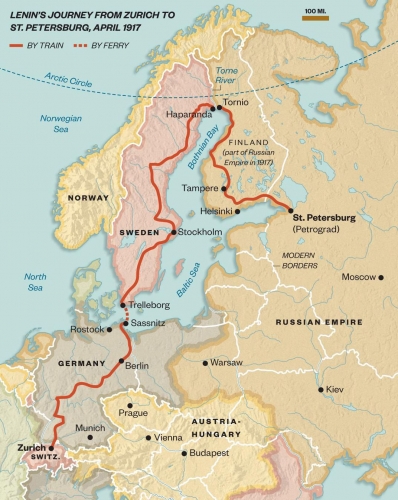
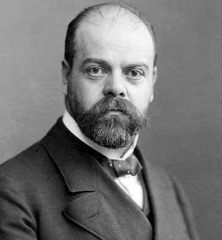 A man known as Parvus appears foremost among the Jews in Lenin in Zürich. Born Izrail Lazarevich Gelfand, he comes across, at least to Lenin, as an enigmatic and somewhat unscrupulous capitalist and millionaire who, for some reason, dedicates his life to socialist causes. Either this, or he wishes to destroy Russia while exhibiting a suspicious allegiance to Germany. Parvus, along with his protégé Leon Trotsky, had tried and failed to overthrow the Tsar in 1905, and now offers a new plan: With his deep contacts in the German government, he will arrange for the Bolsheviks’ to travel through Germany in order to re-enter Russia where they can foment revolution against a weakened Tsar. This would serve not only Lenin but Parvus’ German friends as well by knocking Russia out of the war. Suspicious of Parvus’ outsider status, and especially of his tolerance of Lenin’s detested Mensheviks, Lenin at first refuses. However, he cannot shake his respect and fascination for this mysterious benefactor.
A man known as Parvus appears foremost among the Jews in Lenin in Zürich. Born Izrail Lazarevich Gelfand, he comes across, at least to Lenin, as an enigmatic and somewhat unscrupulous capitalist and millionaire who, for some reason, dedicates his life to socialist causes. Either this, or he wishes to destroy Russia while exhibiting a suspicious allegiance to Germany. Parvus, along with his protégé Leon Trotsky, had tried and failed to overthrow the Tsar in 1905, and now offers a new plan: With his deep contacts in the German government, he will arrange for the Bolsheviks’ to travel through Germany in order to re-enter Russia where they can foment revolution against a weakened Tsar. This would serve not only Lenin but Parvus’ German friends as well by knocking Russia out of the war. Suspicious of Parvus’ outsider status, and especially of his tolerance of Lenin’s detested Mensheviks, Lenin at first refuses. However, he cannot shake his respect and fascination for this mysterious benefactor.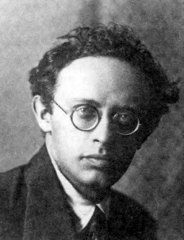 Another Jew who figures prominently in Lenin in Zürich is Radek (born Karl Berngardovich Sobelsohn). Lenin has tremendous respect for Radek as a writer and propagandist — that Radek had become one of the Soviet Union’s most prominent journalists years after Lenin’s death certainly justifies Lenin’s esteem. In all, he is clever and resourceful and the only person to whom Lenin would voluntarily surrender his pen. After the February Revolution in Russia, as Lenin prepares for travel back to his home country according to Parvus’ plan, Radek contrives ingenious solutions to formidable logistical problems that threaten to sink the enterprise. This makes Lenin, for one of the few times in the book, truly happy.
Another Jew who figures prominently in Lenin in Zürich is Radek (born Karl Berngardovich Sobelsohn). Lenin has tremendous respect for Radek as a writer and propagandist — that Radek had become one of the Soviet Union’s most prominent journalists years after Lenin’s death certainly justifies Lenin’s esteem. In all, he is clever and resourceful and the only person to whom Lenin would voluntarily surrender his pen. After the February Revolution in Russia, as Lenin prepares for travel back to his home country according to Parvus’ plan, Radek contrives ingenious solutions to formidable logistical problems that threaten to sink the enterprise. This makes Lenin, for one of the few times in the book, truly happy.





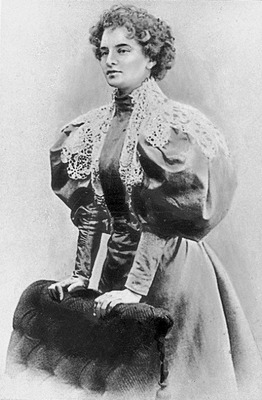
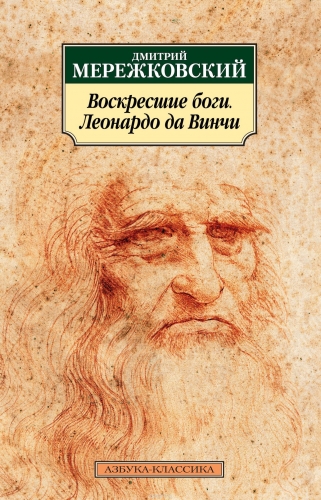
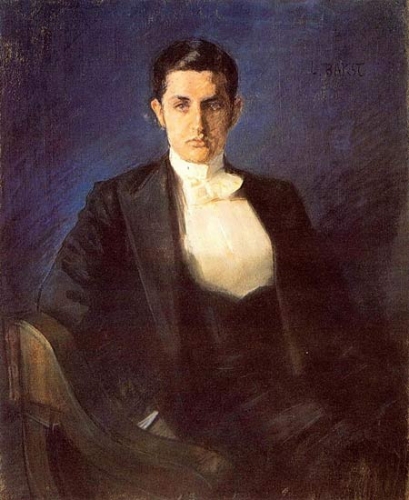
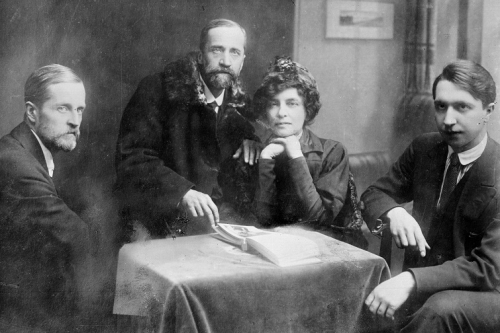
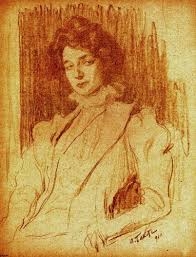 En 1900, l'immense empire russe s'était industrialisé grâce à des emprunts financiers étrangers au moyen de prêts monétaires, sans aucune modernisation de sa structure sociale. Aucune perspective n'était donnée à l'indicible misère de sa population paysanne, soit sans terre à la merci des propriétaires, soit indépendante mais écrasée par les gigantesques taxes destinées à pourvoir au paiement de l'endettement russe (les propriétaires ne payaient pas d'impôts). L'immense sous-classe prolétarienne, qui vit dans des conditions misérables, afflue dans les villes et les centres industriels. L'énorme croissance de la population a permis de compenser les soldats dans l'armée, les ouvriers dans l'industrie, les travailleurs coloniaux sibériens et dans les campagnes. L'Empire est secoué par une politique désordonnée. Des grèves, des manifestations et des affrontements avec la police ont eu lieu dans plusieurs villes. Les radicaux de gauche ont repris le terrorisme politique. Les structures autoritaires rigides de l'autocratie semblaient incapables de réagir ou de saisir ce qui se passait.
En 1900, l'immense empire russe s'était industrialisé grâce à des emprunts financiers étrangers au moyen de prêts monétaires, sans aucune modernisation de sa structure sociale. Aucune perspective n'était donnée à l'indicible misère de sa population paysanne, soit sans terre à la merci des propriétaires, soit indépendante mais écrasée par les gigantesques taxes destinées à pourvoir au paiement de l'endettement russe (les propriétaires ne payaient pas d'impôts). L'immense sous-classe prolétarienne, qui vit dans des conditions misérables, afflue dans les villes et les centres industriels. L'énorme croissance de la population a permis de compenser les soldats dans l'armée, les ouvriers dans l'industrie, les travailleurs coloniaux sibériens et dans les campagnes. L'Empire est secoué par une politique désordonnée. Des grèves, des manifestations et des affrontements avec la police ont eu lieu dans plusieurs villes. Les radicaux de gauche ont repris le terrorisme politique. Les structures autoritaires rigides de l'autocratie semblaient incapables de réagir ou de saisir ce qui se passait. En 1901, Merezhkovsky et son ami Dmitri V. Filosofov, sont devenus les animateurs d'un mouvement philosophique religieux, dont le but était de promouvoir une ''nouvelle conscience religieuse'' en Russie, en fondant la Société philosophico-religieuse, dont l'instrument de diffusion était la revue ''Novyi put'' (La nouvelle voie), qui reflétait leurs idées métaphysiques. Ces réunions régulières étaient connues sous le nom d'Assemblées religieuses de Saint-Pétersbourg et ont duré de 1901 à 1903. Penseur religieux et mystique, il envisage l'avènement d'un nouveau monde de liberté et d'épanouissement chrétien qui s'accomplirait avec la réalisation du Royaume de l'Esprit, invoqué par Joachim de Fiore. L'attente du Troisième Royaume lui impose la nécessité de mener une action concrète, qu'il tente à plusieurs reprises, lors de conférences religieuses et philosophiques en 1901 qui sont mémorables dans l'histoire de la culture russe contemporaine.
En 1901, Merezhkovsky et son ami Dmitri V. Filosofov, sont devenus les animateurs d'un mouvement philosophique religieux, dont le but était de promouvoir une ''nouvelle conscience religieuse'' en Russie, en fondant la Société philosophico-religieuse, dont l'instrument de diffusion était la revue ''Novyi put'' (La nouvelle voie), qui reflétait leurs idées métaphysiques. Ces réunions régulières étaient connues sous le nom d'Assemblées religieuses de Saint-Pétersbourg et ont duré de 1901 à 1903. Penseur religieux et mystique, il envisage l'avènement d'un nouveau monde de liberté et d'épanouissement chrétien qui s'accomplirait avec la réalisation du Royaume de l'Esprit, invoqué par Joachim de Fiore. L'attente du Troisième Royaume lui impose la nécessité de mener une action concrète, qu'il tente à plusieurs reprises, lors de conférences religieuses et philosophiques en 1901 qui sont mémorables dans l'histoire de la culture russe contemporaine. 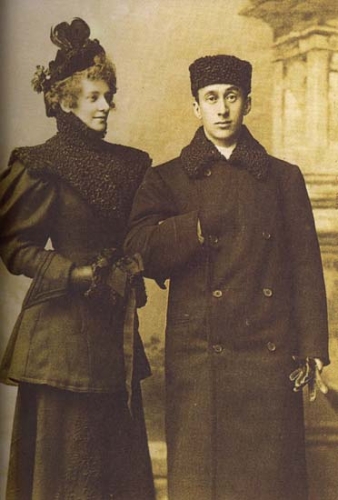
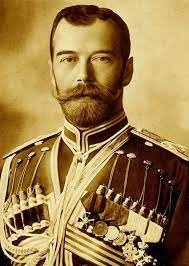 Merezhkovsky soutient la monarchie russe, à laquelle il attribue une institution divine. Il a résisté aux critiques sévères des écrivains progressistes. Il a fait l'objet de moqueries dans un article imprimé dans ''Osvobozhdenie'' en 1902, un périodique clandestin publié à l'étranger, en rapport avec sa comparaison de l'autocratie russe à un ordre mystique dans son livre sur Dostoïevski, signalant que le département de la police, les règlements sur les contrôles étaient intensifiés ; dans ''Moskovskie vedomosti'', ''Grazhdanin'', ''Cossack'', des sarcasmes ont été faits sur les convocations et les potences et autres attributs de protection : étaient-ils également des objets de l'ordre mystique ? Ils contenaient le secret indescriptible de Dieu. Mysticisme oblige. Si l'idée de la monarchie n'est que mystique et qu'elle est promue, non pas comme un son de cloche, mais avec respect et crainte, une telle conviction oblige à lutter furieusement contre l'ordre policier russe. L'autocratie est une idée religieuse, mais la défense d'une telle idée est un argument pour Dieu, et non pour le service de police. Quelles que soient les souffrances et la misère du peuple, le régime tsariste a maintenu son prestige grâce à l'expansion de l'empire russe. Le Caucase, l'Asie centrale et l'Extrême-Orient, des provinces absorbées au XIXe siècle. Au début du 20e siècle, la situation a brutalement changé. Dans la guerre de l'Est, l'impérialisme russe et le Japon modernisé s'affrontent.
Merezhkovsky soutient la monarchie russe, à laquelle il attribue une institution divine. Il a résisté aux critiques sévères des écrivains progressistes. Il a fait l'objet de moqueries dans un article imprimé dans ''Osvobozhdenie'' en 1902, un périodique clandestin publié à l'étranger, en rapport avec sa comparaison de l'autocratie russe à un ordre mystique dans son livre sur Dostoïevski, signalant que le département de la police, les règlements sur les contrôles étaient intensifiés ; dans ''Moskovskie vedomosti'', ''Grazhdanin'', ''Cossack'', des sarcasmes ont été faits sur les convocations et les potences et autres attributs de protection : étaient-ils également des objets de l'ordre mystique ? Ils contenaient le secret indescriptible de Dieu. Mysticisme oblige. Si l'idée de la monarchie n'est que mystique et qu'elle est promue, non pas comme un son de cloche, mais avec respect et crainte, une telle conviction oblige à lutter furieusement contre l'ordre policier russe. L'autocratie est une idée religieuse, mais la défense d'une telle idée est un argument pour Dieu, et non pour le service de police. Quelles que soient les souffrances et la misère du peuple, le régime tsariste a maintenu son prestige grâce à l'expansion de l'empire russe. Le Caucase, l'Asie centrale et l'Extrême-Orient, des provinces absorbées au XIXe siècle. Au début du 20e siècle, la situation a brutalement changé. Dans la guerre de l'Est, l'impérialisme russe et le Japon modernisé s'affrontent.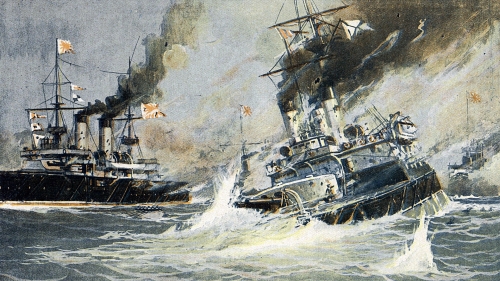
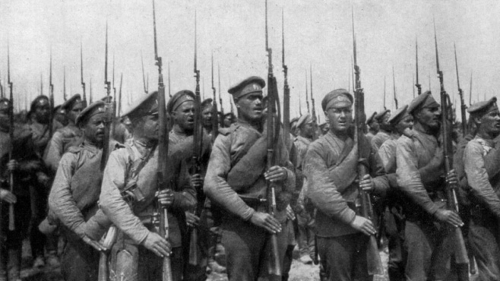
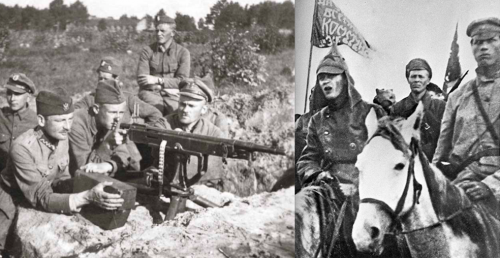
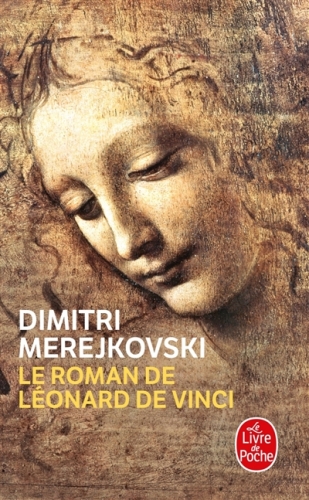
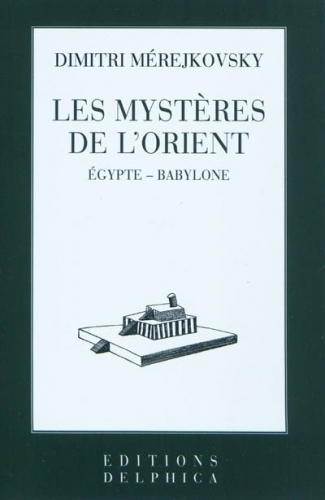
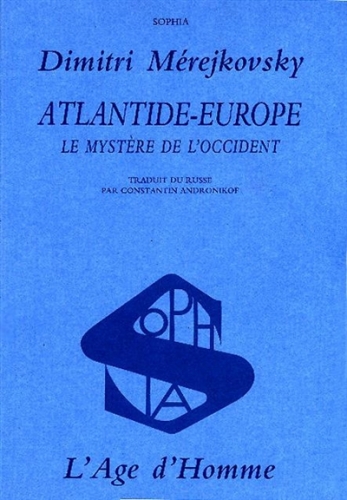

 del.icio.us
del.icio.us
 Digg
Digg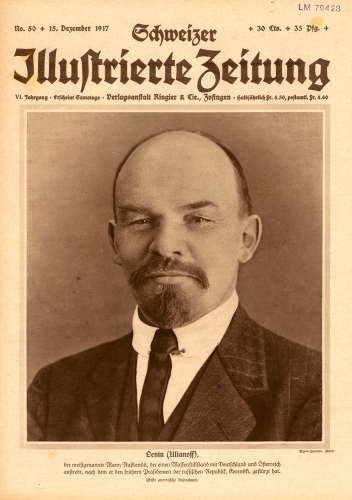
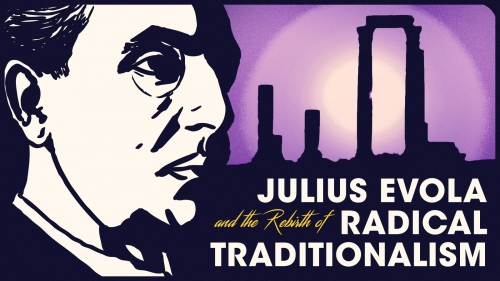
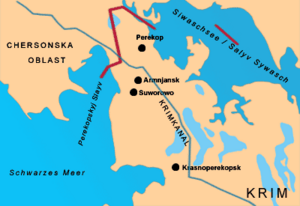 Nell’autunno del 1920 la guerra civile russa era ormai avviata verso la sua inevitabile conclusione, con le armate bianche che cedevano, una dopo l’altra, davanti alla pressione dell’Armata rossa forgiata da Trotzkij e da lui diretta con spietata energia.
Nell’autunno del 1920 la guerra civile russa era ormai avviata verso la sua inevitabile conclusione, con le armate bianche che cedevano, una dopo l’altra, davanti alla pressione dell’Armata rossa forgiata da Trotzkij e da lui diretta con spietata energia.